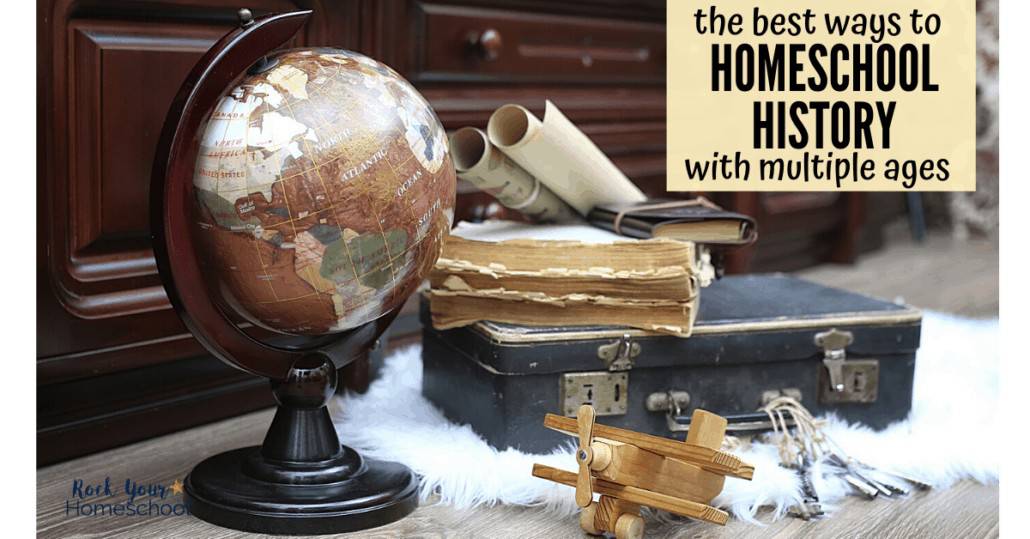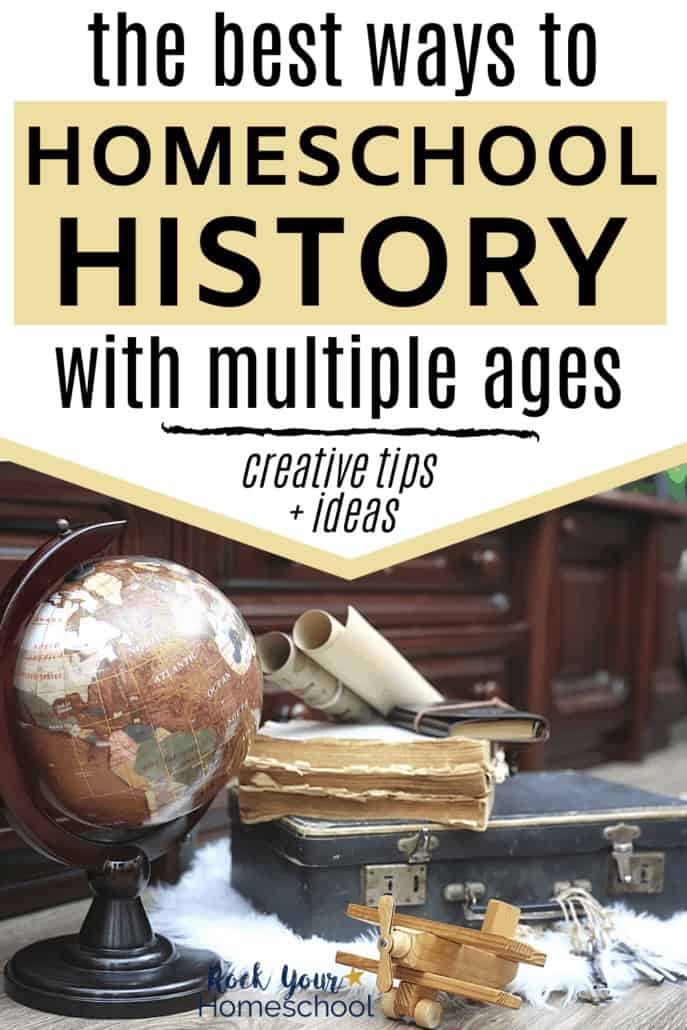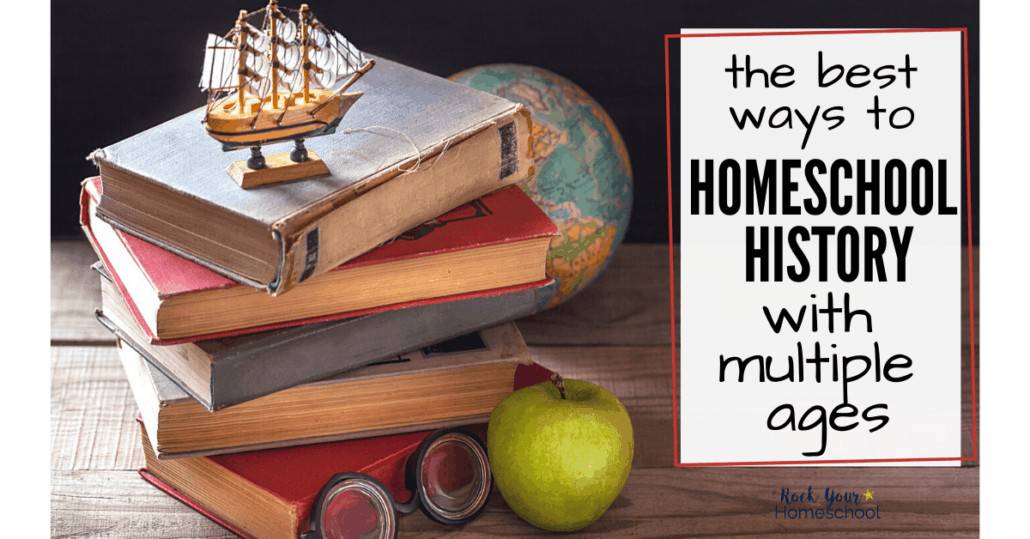The Best Ways to Homeschool History with Multiple Ages
This post may contain affiliate links. Please read my disclosure statement. Thanks for visiting!
Did you know that you can homeschool history with multiple ages?
This option is fantastic for large families who want to save time, energy, and money.
Get creative ideas and tips for homeschooling history with multiple children.

How to Practically Homeschool History with Multiple Ages
As a busy homeschool soccer mom to 5 boys, I love to find and use smart hacks to make life and learning fun. With the right resources and a bit of creativity, you can enjoy a relaxed homeschool style, even if you have multiple ages to each.
Amy Pak, an experienced large-family homeschool mom who co-owns Home School in the Woods, is here to share her tips and tricks on how to homeschool history with multiple ages. I love her practical ideas that encourage homeschoolers to make the most of this special time 🙂
If you're a homeschool parent of multiple children in various grades and with an array of learning styles, you probably look for ways to utilize your time and efforts to the fullest, while providing a substantial education to your kids.
It’s not like you can sit your children down together and teach them all at once, like a regular classroom… or can you?
Yes, at times, you can! And history is the perfect subject for that very thing 🙂

Why Homeschool History Is Fantastic for Combining Ages & Stages
Let’s face it… not everything can be taught with different ages together.
It’s true. Many subjects need to be taught to the age and ability of the child.
Math, reading, and writing are taught precept-upon-precept for the most part. A child must learn to add and subtract before he can learn to multiply and divide. There will generally be a big difference between a seven-year-old reader and a twelve-year-old! Because these subjects are sequential in nature, they are often best taught to the individual and molded to fit their distinct learning styles.
However, there are other subjects that lend themselves wonderfully to multi-level learning!
History, science, the arts and music, health and PE, and Bible study can be approached randomly, depending on the child’s interest.
Typically, there is no set time period that a child needs to spend on a topic, so the schedule can adjust as needed if a topic needs to change.
Since we are a family-run history company, that is going to be my focus.
I’ve often said, you can’t learn all of history in twelve years; the best bet is to engage the child into developing a love of learning rather than a disdain for boring textbooks and rote memorization of names, dates, and places.

Live the Lessons as You Homeschool History with Multiple Ages
Over nearly two decades of educating our children, one of the best ways we were able to homeschool history with multiple ages was by living the lessons.
History is like a series of stories unraveling either chronologically or in random pieces, and who doesn’t like a good story?
Once you’ve chosen a topic to teach, there are a variety of ways to have all the kids involved:
1. Reading:
Of course, each reading assignment will be per each student’s level.
There are so many good living books to choose from! You should be able to find books to suit each child’s needs that pertain to the subject.
As each child reads more of their particular book, offer time to have them share what they are reading about with the rest of the siblings.
Also, I have found that there is no age that doesn’t also love read-aloud time! We did it with our kids right up into high school. There is something about gathering together with a cup of tea or cocoa and flopping onto a comfy chair or couch with a good book for all to hear. These moments also lead to some great discussion time.
2. Projects:
At Home School in the Woods, we are all about hands-on history!
By working on projects together, you can vary the degree of difficulty of a project to each child’s strengths, while still having them work together. The type of work might be working on a diorama, an authentic craft of the era, or making dress-up clothes, to name a few.
It doesn’t mean you can’t create individual projects—it just means that each child will produce projects from their own ability at that time.
For example, if each child makes their own lap book, the projects within them may be simpler for the younger ones, while more would be expected from the older ones.
3. Writing:
Writing will also be according to a child’s level. There are, however, creative ways to do this together!
By creating a family “newspaper” on a topic (such as “The Pioneer Post” or “The Viking Review”), each child could be assigned articles to write and advertisements to market stores, restaurants, and services of the era. They can draw pictures or take photos to insert in the paper.
4. Games:
There is no better way to drill facts and information than with a game!
By creating a file-folder game board on the topic, you can have the children create their own question cards to use with the game. Not only does this help with review of the information, but it also forces the children to focus on the material in order to develop a question-answer format.
You may need to remind the older children that questions should be couched in ways that the younger children can understand.
We’ve found that due to the nature of mass amounts of facts and details, it is best to start with a small number of cards until the kids can master the answers for those. Then, add more cards.
You’d be surprised how the young ones can catch on and retain the information, often winning them the game!
Another fun idea is to try some games or sports of the culture or era you are learning about! This is a great opportunity to take advantage of having a number of people as you homeschool history with multiple ages.
5. Food:
Every culture through history has had to eat!
Teaching through the taste-buds is another wonderful way to bring the family together.
Create snacks or even a full meal that reflects the era or country you are studying. Even picky eaters are often persuaded to try foods they've created themselves!
6. Drama:
Dramatizing is a fantastic way to cement the lessons learned.
Have the children act out scenes they’ve studied about, or create a small play. It doesn’t have to be fancy!
Record it on your phone and play it back for dad when he gets home, or for family and friends!
Dramatizing is another form of oral reporting. Of course, your kids don’t need to know that... but you will!
Give Older Children More Responsibility in Your Homeschool History
Responsibility is an important life skill that you can also be teaching your children in a multi-level setting.
With the older child, assign them ways to oversee the management of the younger ones with certain projects.
This type of responsibility might be through writing and directing the drama, or instruction when it comes to following the recipes.
It might also be taking more initiative to adapt the game to the level of the younger children or by being the one to read aloud to the family.
Your older children will learn about management and communication—skills that will help them in life.
More should be expected of older children when it comes to projects and writing. Research is a necessary skill that learning history teaches, and can be applied to many job opportunities in the future. Younger siblings benefit from watching older children do research, too!
Teaching history to a variety of ages is not just something that is do-able—it is encouraged!
There are many opportunities to work together as a family to accomplish exciting and hands-on aspects of the lessons.
And talk about making memories! You’ll want to have your camera handy for many of the fun times they will share. ...that’s not always something you can easily say about arithmetic 😉
Would you like to homeschool history with multiple ages (or do you already)?
Share your questions or experiences in the comments area below 🙂

